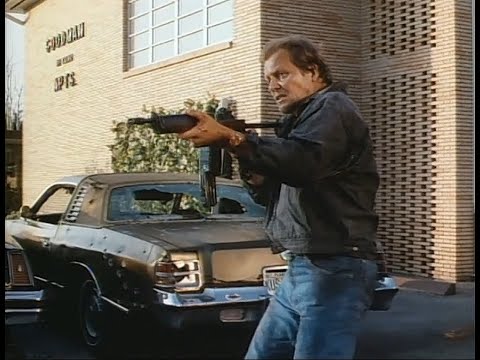In some ways a Manichean story about the clash between the forces of good and evil, the 1988 television true-life docudrama In the Line of Duty: The FBI Murders exemplifies the tendency of such programs to fictionalize what they purport to be true. Retired FBI Agent Edmundo Mireles Jr., in correspondence with this writer, has called the movie “about 50% accurate,” and having “taken a lot of liberties which led to a lot of embellishment and rewriting history to suit a script.” Nevertheless, on its own merit, The FBI Murders is an arresting movie, well worth examining, because it reveals an amazing symbiosis of truth and fiction in the presentation of crime and makes us understand the complicated relation of a docudrama to the events it depicts.
The villains in the movie conceive of themselves as believers in a militaristic code. They cloak their criminal behavior in the guise of commando operations. The heroes are federal agents, some of whom are military veterans and staunch believers in law and order, who engage in violence mainly or only to protect the lives of the innocent. While the movie’s conventions are stereotypical of American society in the 1980s, a decade that has been largely defined by the reign of President Ronald Reagan, these stereotypes convey a nostalgia for the clarity of values extolling right and wrong. Audiences generally flocked to the Rambo and Indiana Jones franchises because they longed for that clarity. The FBI Murders follows this trend. Interestingly in some scenes, agents apply the labels “Soldiers of Fortune” and “Rambos” to the villains. This suggests a fusion of the era’s pop culture icons into both the heroism and the wickedness depicted in the events of the story, which speaks to their lasting power in art and cinema.
In his 1770 speech “Thoughts on the Cause of the Present Discontent,” Edmund Burke proclaimed, “When bad men combine, the good must associate, else they will fail, one by one, an unpitied sacrifice in a contemptible struggle.” A political party by implication can be translated as a community. The Federal Bureau of Investigation, as depicted in the movie, is a form of clan and community, united in its duty and purpose to root out criminality. The movie’s heroes are a band of brothers. Like any club, this particular Miami-based reactive unit—nicknamed “Funsters” by its members— has its code phrases, its initiation rituals, its training procedures, and its individual monikers for every member.
The backstory is as follows: Over a several-month period from late 1985 to the spring of 1986, Miami, Florida, as well as the surrounding rural areas, were subjected to a series of related violent crimes, committed by two heavily armed, well trained, army ranger veterans, identified later as Michael Platt, 32, and William Matix, 34. Together, these two devoted family men formed a folie à deux—shared psychosis—not dissimilar to that of Hickock and Smith, murderers of the Clutter family in Kansas, as chronicled by Truman Capote in 1966’s In Cold Blood.
Platt and Matix murdered motorists in order to steal ‘drop cars’ for the purpose of committing armed heists of banks and armored cars. During these robberies they maimed and killed guards and terrorized civilians in hails of wild gunfire. It is widely believed that both Matix’s and Platt’s first wives met fatal ends at their husbands’ hands, because the women were inconveniently in the way. According to Mary Thornton of the Washington Post, on Christmas Eve 1984 in Miami, “Platt’s wife Regina died of a shotgun blast to the head. Police at the time ruled it a suicide.” Agent Gordon McNeill would later lament this ruling: “If she was a suicide, that would make her the first woman in the history of the FBI to kill herself with that kind of a gun that way.”
Just one year earlier, on December 30, 1983, in Columbus, Ohio, Matix’s wife Patty had been murdered in a purported robbery gone awry, along with a coworker Joyce McFadden at the hospital at which they were employed at. Reporter Michelle F. Solomon recounts Patricia Matix’s demise in vivid detail: “Joyce McFadden has been bound and gagged and stabbed to death. Patricia Matix is stabbed 16 times and her wedding ring is stolen.” There is no doubt this double homicide outdoes the imaginations of the creators of iconic slasher movie characters Michael Meyers and Freddy Krueger.
On April 11, 1986, when cornered by a unit of plainclothes FBI agents, following a highspeed chase, the suspects engaged the officers in a minutes-long firefight that left the two killers, along with the agents Benjamin Grogan and Jerry Dove, dead on arrival, with several other agents critically wounded. Since then, the case continues to be shrouded in infamy as one of the bloodiest shootouts in law enforcement history.
Part two will be posted next week.
Go to Source
Author: The Best American Poetry

